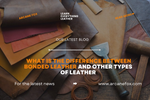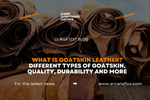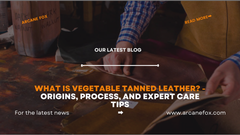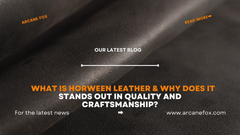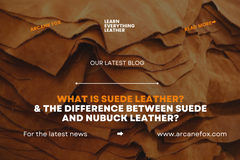What is Cowhide Leather? Origins, Types, and Maintenance
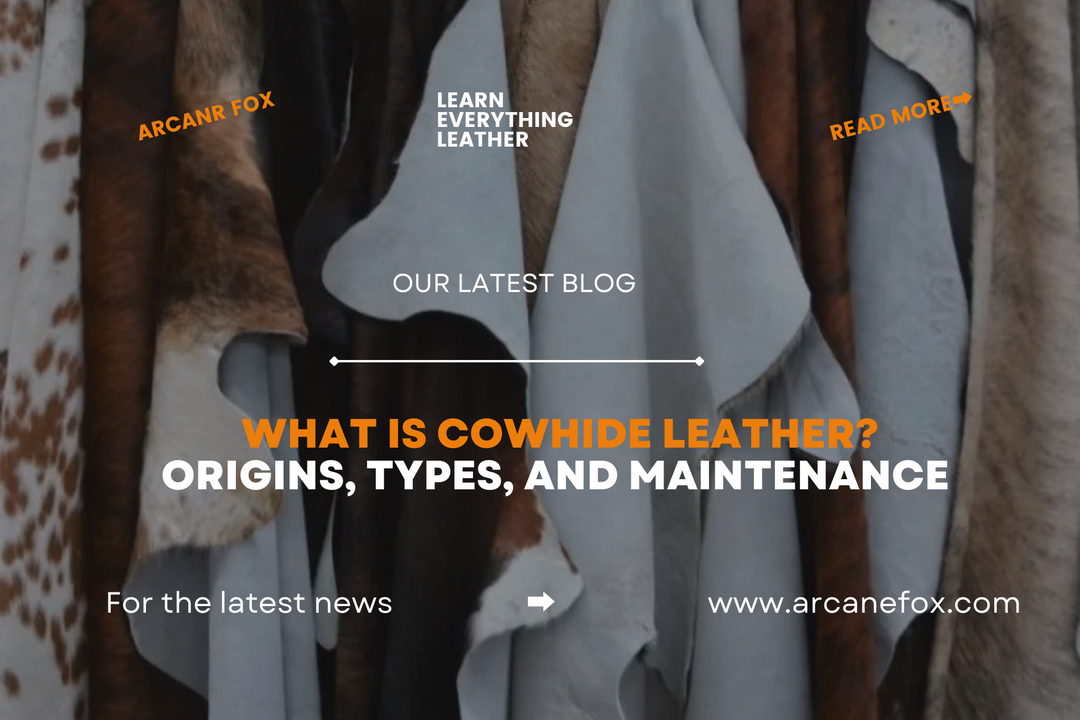
What is Cowhide Leather? Origins, Types, and Maintenance
For more than a thousand years, people have utilized various animal hides, including cowhide leather. Some of the earliest methods of turning animal hide into leather involved employing implements like scrapers that were used to remove fat from the hides in addition to tanning them.
Yet, what is cowhide leather? What is grain cowhide leather? Where does it fit into all of this, and how is it different from other types of leather? Find out more below.
1. Cowhide Origins
You should understand what cowhide leather means before continuing. Cowhide is made from a cow's natural, unbleached skin and hair. Despite being a byproduct of the cattle-related food business, it is frequently used to make leather.
This type of leather is often called cattle leather, highlighting its origin from cows. Known for its durability, toughness, and natural grain, cattle leather is widely used in jackets, shoes, and furniture. It balances strength with comfort, making it one of the most trusted choices in leather crafting.
2. History of Cowhide Leather
The use of cowhide dates back many centuries. Cowhide was used to manufacture clothes by ancient civilizations throughout Latin America, including the Incas and Aztecs. During the Middle Ages, cowhide was also widely utilized in Europe to create saddles and armor.
These conventional uses have changed throughout time to meet our contemporary needs. Cowhide is still widely used today to create upholstery, boots, bags, and leather coats. When properly maintained, its timeless look and longevity allow it to outlive the owner.
3. How Cowhide Leather is Made?

Cowhide refers solely to the animal from which the leather was sourced, not to a particular finish, yet it is tanned in the same manner as most leathers.
The hide is taken to a tannery where the hair is either treated to come off or left on — for hair on cowhide. The hide is therefore ready for tanning at that point.
The tanning procedures, whether they be chrome or veg-tanned, differ slightly. The hide is immersed in a tannin-rich bath, which is primarily formed of tree bark, when creating leather that has been vegetable tanned. Depending on the application, it may be allowed to sit for anywhere between a month and a year. The hide is retrieved after it has sat in the tanning solution and is now preserved.
Different from other types of leather, chrome-tanned leather is preserved and softened by soaking the hide in a bath of chemicals such as chrome salts. Following tanning, the hide is typically drum color to give it a rich finish. It only takes a few days to finish the whole process.
4. From Cowhide to Leather
Cowhide leather is the end product of many different procedures, some of which are more widespread than others, such as tanning cowhide leather.
These raw materials are put through several labor-intensive processes beginning with curing, follow by rewetting, and then operations that work to methodically eliminate all traces of hair and flesh impurities. It all starts with the careful selection of high-quality animal hides.
The crucial leather tanning process that follows involves treating hides with substances like chromium salts or vegetable tannins to help the leather's fibers become stronger and more durable.
These previously common cowhides now emerge as leather after being given the finishing touches of coloring and finishing, ready to be fashioned into a variety of fashionable items that eventually adorn our houses, clothing, and other items.
5. Clearing Up Myths & Misconceptions
There is a fallacy that all cowhide leather is created equal. Cowhide, on the other hand, exclusively relates to the source of the leather; therefore, this is far from correct. Cowhide is available in a wide range of cuts, treatments, and quality, including:
- Full Grain Cowhide
- Top Grain Cowhide
- Genuine Cowhide
- Suede Cowhide
- Hair on Cowhide
These are all illustrations of the many cowhide cuts and finishes that are available. Each distinction usually refers to the layer of cowhide that was utilized. The top layer of the hide is called full grain, then top grain, then genuine leather, with full grain leather being the best and genuine leather being the worst.
6. What is the Difference Between Cowhide Leather and Other Types of Leather

Leathers differ among themselves to some extent, just like anything else. In some ways, cowhide may be superior to goatskin, while vice versa may be true in other situations.
Below, we describe how cowhide differs from sheepskin, goatskin, and lambskin as well as other varieties of leather. primarily because these are the types of leather that are most frequently utilize. You can also learn about the various varieties of cowhide leather and some of its common applications from this.
6.1 Cowhide Leather vs Goatskin Leather
Grain cowhide may be quite tough, which makes it stronger than goatskin leather, but it lacks goatskin's suppleness and degree of stretch. Even when fully completed, cowhide tends to weigh more than goatskin, which is significantly less.
Cowhide leather provides more warmth than goatskin leather if you're looking for insulating qualities. The same holds for touching. Goatskin leather is smoother and softer than cowhide.
6.2 Cowhide Leather vs Sheepskin Leather
Cowhide is far superior to sheepskin in terms of both the strength and durability of the two types of leather. Compared to cowhide, sheepskin leather is far more elastic and flexible. Sheepskin weighs far less than cowhide, just like goatskin does.
Sheepskin leather is less insulating than cowhide, which provides more warmth. However, sheepskin is far superior to cowhide in terms of softness and suppleness.
6.3 Cowhide Leather vs Lambskin Leather
Cowhide is far superior to lambskin in terms of strength and durability. Although it shouldn't come as a surprise, lambskin stretches far more easily than cowhide. similar to sheepskin in several ways. Cow leather weighs more than lambskin in terms of weight, which is again not surprising, and it also insulates far better than lambskin. Contrarily, lambskin is much softer and more pliable than cowhide.
7. Types Of Cowhide Leather

There are a types of fascinating sorts of cowhide leather, each with unique qualities and uses. You can use the information provided below as a helpful guide to assist you choose a cowhide leather product after doing some research on the many sorts of cowhide leather.
7.1 Full-grain Leather
The top-quality cowhide leather, manufactured from the cow's skin's outermost layer. The strength, durability, and distinctive natural grain patterns of full-grain leather are well known.
7.2 Top-grain Leather
The top layer of the skin is taken off to produce this sort of leather, which is then sanded to produce a flat surface. Top-grain leather is nevertheless of high quality and frequently used in luxury goods; however, it is slightly less resilient than full-grain leather.
7.3 Suede Leather
Suede leather is create by sanding the inner layer of cowhide to create a plush, fuzzy appearance. Although highly regarded for its texture and appearance, this type of cowhide leather is not as durable as others.
7.4 Nubuck Leather
Nubuck leather mimics suede despite being made from the outer layer of cowhide. Because it can be sand to provide a soft, velvety surface, it is widely use in high-end products like luxury purses and shoes.
7.5 Split Leather
The innermost or center layer of the cowhide is separate from the outside layer to create split leather. It is frequently utilize in lower-end products because it is less durable than full-grain or top-grain leather.
8. Pros of Cowhide Leather
Cowhide is one of the leathers that is most commonly available to us makers, making it a very accessible choice. It may be found in a huge selection of thicknesses, hues, and finishes, making it perfect for almost any project. Several advantages of cowhide leather include:
- Durability
- Versatility
- Ease of maintenance
- Cost-effective
- Smooth texture
9. Cons of Cowhide Leather
The quality of the hide is the major drawback when it comes to cowhide. Manufacturers frequently use terms like "authentic" or "genuine" cowhide to characterize the product. This can be perplexing and frequently serves as a marketing gimmick to raise the price of a subpar piece of leather. Keep in mind that full-grain and top-grain leather are of the greatest grade, whereas genuine leather is frequently of lower quality.
10. Our Personal Research on Cowhide Leather
One of the topics I found to be most fascinating when conducting my own research was the marketing of leather. It is simple for a maker to visit a leather supply shop and examine and feel the cowhide there. It is harder to judge a product's quality when purchasing commercial goods or ordering leather online.
11. Cowhide Leather Care and Maintenance
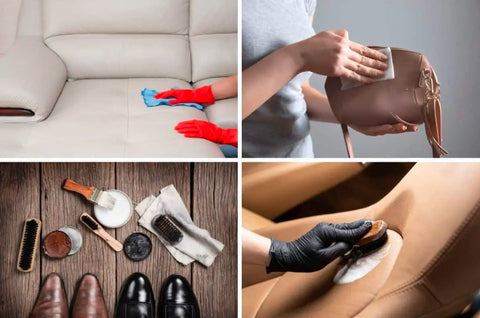
11.1 How To Clean Cowhide Leather?
The process of cleaning cowhide varies depending on the finish. Use a soft bristle brush to remove any surface debris and dust from the majority of chrome- and veg-tanned leather. After that, clean the leather with a moist cloth or a mild leather soap.
The procedure is significantly simpler when using cowhide with hair. Generally, all that is required is a soft-bristle brush to remove any surface-accumulating debris. A mild leather shampoo can be use to remove stains and excessive soiling without harming the hair.
The most care must be taken with suede because wetness can ruin the leather's nap. When washing suede, use a shampoo designed for suede and a soft-bristle brush. Always use a spray-on sealer made specifically for suede after cleaning and drying it, as this will help the material become waterproof and lessen the frequency of subsequent cleanings.
11.2 How To Condition Cowhide Leather?
Use a leather-specific conditioner, such as a leather cream, to condition veg-tanned and chrome-tanned leather. The leather will be rehydrated as a result without losing its color. Cowhide with hair on it usually doesn't need conditioner, but if it feels dry, use it solely on the flesh side.
11.3 How To Store Cowhide Leather?
It is best practice to keep cowhide out of direct sunlight and away from hot or humid surroundings, as is the case with all leather goods. If at all possible, store your cowhide in a dry, cold place after cleaning it. To keep the dust off, it is usually advisable to place your item in a soft, lint-free bag.
Check out this useful video contrasting cowhide and calfskin since they are two popular varieties of leather.
12. Key Takeaways
- Cowhide leather comes in a variety of finishes.
- All cowhide leather comes from bovines.
- Cowhide is a versatile leather that has been used for centuries.
13. Everything We Know About Cowhide Leather
Cowhide leather: What is it? Cowhide leather: is it good? If all of the aforementioned information were to be distilled into a single sentence, it would be fair to state that cowhide leather is not only one of the most prevalent and historically significant varieties of leather, but it is also one of the most useful.
Cowhide genuine leather has great longevity, incredible strength, awesome insulation that keeps you warm, and last but not least, it is a type of leather you can rely on. It may not always look good, feel luxuriously soft, or be as flexible and stretchable as most leathers, but it does offer these benefits.
Learn more about leather here: Leather 101 - The Ultimate Guide to Different Types of Leather
Related Posts:
- What is Goatskin Leather? Different Types of Goatskin, Quality, Durability, and More
- What is Sheepskin Leather? Everything You Need To Know
- What is Lambskin Leather? The Ultimate Guide on Quality, Durability and More
- What is Exotic Leather? Origins, Types, Care, and more
- What is Calfskin Leather? It's Quality & Durability Against Other Leather!
- What Is Shearling Leather? The Truth No One Told You About This Luxe Material

